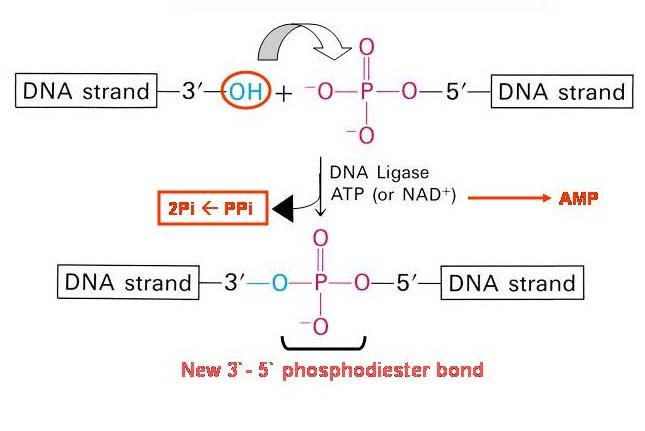L8 DNA&RNA Ligase
一、The function of an DNA ligase
Definition:
- DNA ligases catalyze the formation of a phosphodiester bond between
- DNA single strands in the duplex form.
What’s the function of DNA ligase in vivo ?
- DNA damage repair
- DNA recombination during Meiosis and antibody formation
- Seal the gaps during DNA replication

三、DNA ligase & RNA ligase
T4 DNA ligase
Origin: T4 Phage
Feature:
- Favor dsDNA over ssDNA. Much less efficient in ssDNA ligation
- Use ATP as energy source
**Usage: **
- Repair the single stranded nick in the double stranded DNA or RNA
- Join blunt end and cohesive end termini

E.coli DNA ligase
Origin: E.coli
Feature:
- Use dsDNA as substrate, much less efficient on ssDNA
- Use NAD as a cofactor and energy source
- Only repair cohensive end but not blunt end
Usage:
- Selective ligation of nicks in dsDNA

T4 RNA ligase I
Origin: T4 phage
Feature:
- It is a single stranded ligase
- Substrate include both ssDNA and ssRNA
Usage:
- Ligate a ssDNA/ssRNA with a ssDNA or ssRNA adaptor (NGS library prep)

T4 RNA ligase 2
Origin: T4 phage
Feature:
- It is a double-stranded RNA ligase
Usage:
- Seal nicks in dsRNA.
- Ligate the 3’OH of RNA to the 5’ phosphate of DNA in a double stranded structure

| dsDNA | ssDNA | dsRNA | ssRNA | Comments | |
|---|---|---|---|---|---|
| T4 DNA ligase | ✔ | ✔, but much less efficient | X | X | 1. ATP as energy source 2. Joint blunt and cohesive end |
| E.coli DNA ligase | ✔ | ✔, but much less efficient | X | X | 1. NAD as energy source 2. Joint cohesive end |
| T4 RNA ligase 1 | X | ✔ | X | ✔ | |
| T4 RNA ligase 2 | X | X | ✔ | X |
四、Pre-adenylated adaptor
5’ Pre-adenylated adaptor
DNA/RNA-adenylate is a intermediate of ligation reaction
Pre-adenylated 5’ end can increase ligation efficiency of T4 DNA/RNA ligase significantly

rAPP-Adaptor:

五、Consideration for a ligation reaction
- Choose the right ligase according to the substrate
- Ligation temperature, time and buffer composition
- Check if 3’OH and 5’ P exist in your substrate
Some primers do not have 3’-OH or 5’-P, therefore the PCR product do not has these functional groups in the 5’ and 3’ end too. Therefore, there will exist a nick after ligation reaction (hard for ligation).
L8 DNA&RNA Ligase
https://zhenyumi.github.io/posts/6a4338bb/